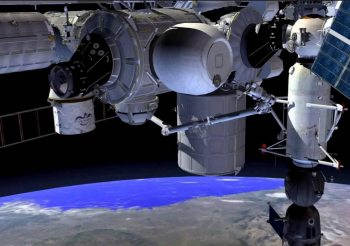ISS controllers defer BEAM module expansion

Tags: USA
ISS controllers defer BEAM module expansion published by Mooba
Writer Rating: 0
Posted on 2016-05-26
Writer Description: Brandon
This writer has written 186 articles.
The International Space Station (ISS) was to gain a new module for the first time since March 2011 on Thursday, as the Bigelow Expandable Activity Module (BEAM) was to be expanded to its full size, bringing an end to an almost two-decade long effort to place an inflatable module on the station. However, the expansion process did not go to plan, resulting in further work being postponed.
Inflatable modules background:
The concept of inflatable modules has been studied by NASA as far back as the early 1960s, with the goal of reducing the size and mass of a module for the launch phase, while allowing for greater usable volume once in space.
However, it was not until 1997, one year prior to the launch of the first component of the ISS, that NASA actually proposed to develop an inflatable module in the form of the TransHab concept, which was designed as an alternative to the ISS Habitation module (which itself was later cancelled).
TransHab was a very large module which would have contained crew quarters, exercise equipment, hygiene facilities, food preparation hardware, and storage for the ISS, as well as serving as a technology demonstration for future deep-space inflatable habitats.
Ultimately, the rising costs and lengthy delays experienced by the ISS program in the late 1990s led to NASA being ordered to cease all work on the TransHab concept in 2000, which effectively ended the prospect of seeing an inflatable module on the ISS.
However, in the early 2000s, commercial company Bigelow Aerospace, founded by businessman Robert Bigelow in 1999 with the aim of developing the world’s first commercial space station, purchased the rights to the TransHab patents developed by NASA and continued to conduct research into the field of inflatable space modules.
In 2006, using company funding,Bigelow Aerospace launched the first ever inflatable module into space, the Genesis I, aboard a Russian Dnepr rocket. The module was only small, but it successfully proved the concept that a module could be launched deflated, and later inflated and retain pressure once in space.
After nearly ten years on-orbit, Genesis I still retains its pressure integrity, proving that inflatable modules are viable as long-term space habitats. In 2007, Bigelow Aerospace launched a second inflatable demonstration module,Genesis II, into Low Earth Orbit, which also continues to hold pressure with no issues.
Since that time, Bigelow Aerospace has continued to conduct research into, and refine concepts for inflatable modules, however with a current lack of commercial human spacecraft, finding an initial customer for an inflatable commercial space station has proven challenging.
A Bigelow module on ISS:
In January 2011, NASASpaceflight.com was made aware of a proposal to fly a small Bigelow inflatable module on the ISS as a technology demonstration activity.
This presented benefits to Bigelow in the form of demonstrating an inflatable module in a human environment, thus improving potential customer confidence, and to NASA by validating the concept of inflatable modules for use in future exploration architectures.
After nearly two years of negotiations, a 17.8-million-dollar contract between NASA and Bigelow was signed in December 2012, in a now increasingly common (and successful) practice whereby NASA contracts ISS services to commercial providers, rather than try and develop capabilities entirely on its own.
BEAM is a relatively small module as compared to other ISS modules, with an internal volume of 565 cubic feet / 16 cubic meters. It is constructed from two metal bulkheads at either end of the module, and multiple layers of impact-resistant material in between. It features a smaller, unique Common Berthing Module (CBM) hatch than the standard ISS CBM hatches.
BEAM contains radiation sensors to record the levels of radiation inside the module, which research has shown may actually be less than standard metal modules due to the fact that the vinyl polymer material used in BEAM’s construction exhibits radiation shielding properties.
In addition, BEAM will contain impact sensors to detect any debris strikes that may occur, although BEAM is certified to withstand the same impacts as metallic modules. Theory also suggests that inflatable modules could be better able to withstand debris impacts than metal modules, as inflatable modules may deform to absorb impacts more than rigid metal modules.
BEAM also features a temperature sensor, a pressure sensor, and a sensor to record dynamic loads during module inflation. This information will be gathered over BEAM’s two-year lifespan, resulting in a wealth of data regarding the function of an inflatable module in a crew environment.
BEAM inflation:
Following its launch inside the CRS-9 Dragon on 8th April and its installation to the Node 3 Aft port on 16th April, BEAM was to be inflated, also termed “expanded” Thursday after sitting dormant on the Station port for over one month.
Notably, the module has been tightly packed in its launch configuration since last year in preparation for what was a delayed March arrival for integration with the CRS-8 Dragon Trunk, which had led to questions into how it would perform from even Robert Biglow himself.
The actual inflation process is mostly an automated sequence controlled using a specially designed deployment controller located inside the ISS, with some manual input required by the crew at certain stages.
With the vestibule pressurisation and Node 3 Aft CBM hatch opening having already occurred, the first stage of the inflation was to close the ascent vent valve, which has been ensuring that BEAM has been kept at vacuum since its launch into space last month.
The restraint straps that have been keeping BEAM in its tightly packed form were then be released, following which the module’s bulkhead will be released in order to allow it to expand, whereupon the actual inflation process will begin.
This was the initial issue, with the NASA Standard Initiators (NSIs) failing to indicate they had fired, which is required to ensure the straps would release as the module expanded.
However, after some troubleshooting, Jeff Williams was able to confirm the NSIs had fired, allowing for the process to continue.
Unlike the traditional model of inflation, where air is blown directly into the object in the same way as a balloon is inflated, in the case of inflatable modules, air is actually blown into bladders located between the layers of material that make up the module’s skin.
Originally, the plan was to use air from tanks located inside BEAM to inflate these bladders, however analysis showed that this could cause expansion to occur too fast and potentially place damagingly high loads on the ISS in the process, so instead the air will be supplied from the station in a more controlled manner.
As such, this was done via Williams opening a Manual Pressure Equalisation Valve (MPEV) on BEAM’s hatch.
It was not actually known precisely how the inflation dynamics would occur, as it has only ever been done twice before (Genesis I and II), neither of which were of the same construction or size as BEAM.
This proved to be a learning curve, as after two hours of adding a few seconds of air into the module, only the width expanded, as opposed to the length.
Mission controllers decided it would be best to defer operations for the day to allow them to evaluate the next steps.
There are four separate models for how BEAM may actually fully inflate, but it remained to be seen how precisely this would realize via the actual process. The BEAM deployment itself will provide valuable data as to how modules expand in space, which will help inform future inflation models.
Once BEAM is fully inflated, the interior volume will still be unpressurised, as air will not have been pumped into the module itself during the expansion phase. Thus, eight air tanks located inside BEAM will then be used to pressurise the module to ISS atmospheric pressure.
An 80-hour leak check phase will then be performed, prior to BEAM’s hatch being opened, which will allow for the historic milestone of humans being able to enter an inflatable module in space for the first time, in the process giving the ISS a new module for the first time since March 2011 with the installation of the PMM.
However, the hatch will not remain open for long, as for the majority of the time it will stay closed, due to the fact that BEAM is actually classed as a technology demonstration experiment, rather than an additional module for the ISS. The crew are planned to periodically enter BEAM around 2-3 times every 6 months, in order to conduct a check of the interior and replace some sensors.
BEAM will not be used for any storage during its time on the ISS, since it’s technology demonstration status presents a risk of potentially losing any hardware stored inside BEAM in the event of an issue occurring with the module.
After a two-year demonstration period, BEAM will be depressurised and removed from the ISS via the station’s robotic arm, whereupon it will be released to burn up in earth’s atmosphere upon its eventual re-entry.
The future of inflatables:
While BEAM represents the end of a nearly 20-year journey to place an inflatable module on the ISS, going all the way back to TransHab in the late 1990s, it marks only the very beginning for inflatable modules in human spaceflight.
Bigelow Aerospace recently announced their intention to launch one of their larger BA-330 modules into space by 2020, with an Atlas V launch already booked. Bigelow also made no secret of their desire to see the BA-330 placed on the ISS.
Called XBASE (eXpandable Bigelow Advanced Station Enhancement), the module would increase the pressurised volume of the ISS by 30 per cent, and serve as a full-scale demonstrator of inflatable modules for use in future exploration, in addition to being made available to commercial customers for scientific experiments.
Post-ISS, NASA wishes to turn over the Low Earth Orbit experimentation business to the private sector, where the prospect of an entirely commercial Bigelow space station is a distinct possibility.
And in the longer term, while future exploration architectures continue to be in a state of flux, it is highly likely that any future architecture, be it government or commercial, will feature inflatable modules. And, once again, ISS is serving as the pathfinder for that future, whatever form it may ultimately take.
Sources: http://deadline.com/2016/05/mirrors-edge-video-game-adapted-tv-endemol-shine-studios-1201762639/
You have the right to stay anonymous in your comments, share at your own discretion.


